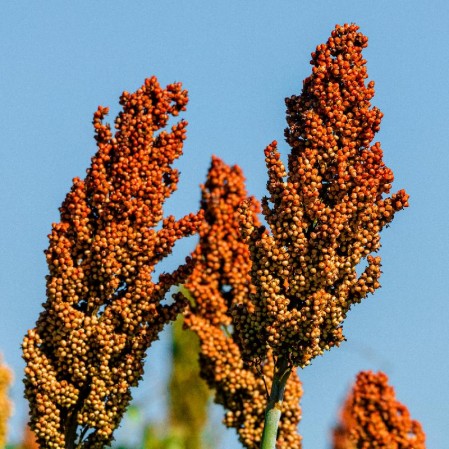Multi Colored Broom Ornamental Corn Seeds
- HOW TO GROW
- FAST FACTS
- REVIEWS
HOW TO GROW
Sowing: After the last spring frost, plant the seeds 1" deep. Thin them to 3-6" apart in rows 3' apart.
Growing: Though broom corn tolerates drought and poor soil well, the best brooms grow with adequate moisture and fairly high temperatures. For making brooms or other purposes that require straight straws, the stalk will need to be bent 20-24" from the top to allow the brooms to hang straight down.
Harvesting: When the entire broom turns from pale yellow to light green, it is ready to harvest. If the broom begins to take on a red color, it is past the optimum stage for harvesting.
Seed Saving: Save seed from as many plants as possible to promote genetic diversity. As soon as the stalks start to dry, the brooms can be cut and the seed removed by running your hands down the stems. Dry the seeds for several weeks out of direct sunlight. A good test to determine whether the seeds have completely dried is to hit one with a hammer. If it shatters, it is ready to store; if it just looks flattened, continue drying. Store in a cool, dark place for up to four years.
FAST FACTS
Latin Name: Sorghum bicolor
Type: Open Pollinated, Heirloom, Warm Season
USDA Zones: 3, 4, 5, 6, 7, 8, 9, 10, 11, 12
Seeds per Ounce: 1,150
Planting Method: Direct Sow
Sunlight: Full Sun
Height: 96 Inches
Color: Red, Brown
well packaged
Seeds arrived well packaged.Should be high germination rate. Super pleased.
DESCRIPTION
HOW TO GROW
Sowing: After the last spring frost, plant the seeds 1" deep. Thin them to 3-6" apart in rows 3' apart.
Growing: Though broom corn tolerates drought and poor soil well, the best brooms grow with adequate moisture and fairly high temperatures. For making brooms or other purposes that require straight straws, the stalk will need to be bent 20-24" from the top to allow the brooms to hang straight down.
Harvesting: When the entire broom turns from pale yellow to light green, it is ready to harvest. If the broom begins to take on a red color, it is past the optimum stage for harvesting.
Seed Saving: Save seed from as many plants as possible to promote genetic diversity. As soon as the stalks start to dry, the brooms can be cut and the seed removed by running your hands down the stems. Dry the seeds for several weeks out of direct sunlight. A good test to determine whether the seeds have completely dried is to hit one with a hammer. If it shatters, it is ready to store; if it just looks flattened, continue drying. Store in a cool, dark place for up to four years.
FAST FACTS
Latin Name: Sorghum bicolor
Type: Open Pollinated, Heirloom, Warm Season
USDA Zones: 3, 4, 5, 6, 7, 8, 9, 10, 11, 12
Seeds per Ounce: 1,150
Planting Method: Direct Sow
Sunlight: Full Sun
Height: 96 Inches
Color: Red, Brown
Reviews
Review
well packaged
Seeds arrived well packaged.Should be high germination rate. Super pleased.





